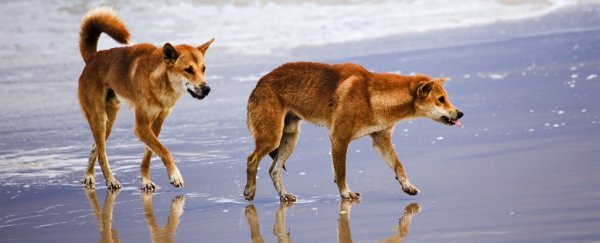Dingoes face quite a few threats across Australia, including habitat loss, lethal control and interbreeding with domestic dogs – and because of that, the number of 'pure' dingoes has been dropping at an alarming rate.
But a new genetic study says that dingoes in southeastern Australia might be particularly under threat, with research finding two genetically distinct populations that migrated to Australia separately.
Dingoes aren't domestic dogs or wolves, they are a weird in-between, which makes them so valuable to researchers looking at the evolution of dogs.
This new research, by scientists at the University of New South Wales (UNSW) and the University of California, samples 127 'pure' dingoes across Australia, and added a separate data set of 79 male dogs and 94 extra dingoes.
What the researchers found was a 'north-western' genetically distinct dingo population found in Western Australia, the Northern Territory and some parts of South Australia, and also in central and Northern Queensland.
There was then another 'south-eastern' population found in New South Wales, the Australian Capital Territory, Victoria and southern parts of Queensland (including Fraser Island).
Although we can't be sure what caused these two separate populations, the researchers believe the two groups may have migrated separately from Papua New Guinea over a now flooded land bridge between 8,000 to 10,000 years ago.
The research team now recommends that the two dingo populations be treated separately for management and conservation purposes.
"Care should be taken not to move dingoes between the different wild populations," says lead researcher and UNSW scientist Kylie Cairns.
"And captive breeding programs should ensure the two dingo populations are maintained separately, with genetic testing used to identify ancestry."
This population separation highlights the need to prioritise conservation of certain populations and make steps to reduce the risk of pure dingoes interbreeding with domestic dogs.
This is especially important for the south-eastern population of dingoes, which is threatened by genetic dilution, habitat loss and lethal control measures such as baiting and the recently reintroduced wild dog bounty in Victoria.
"Effective containment or neutering of male dogs in rural areas may help achieve this reduction in inter-breeding," says Cairns.
"Additionally, baiting and culling practices break apart dingo packs, leading to increased incidences of hybridisation. Alternative livestock protection measures need to be explored, such as livestock guardians, predator deterrents and improved dingo-proof fencing."
The research has been published in Ecology and Evolution.
UNSW Science is a sponsor of ScienceAlert. Find out more about their world-leading research.
